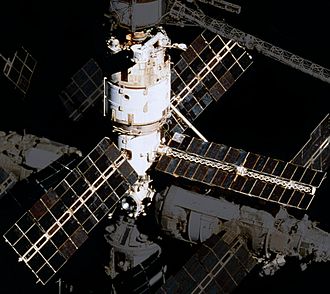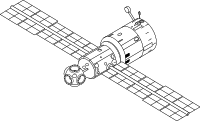- Mir Core Module
-
 DOS-7 seen in 1987 following the addition of a third solar array and Kvant-1.
DOS-7 seen in 1987 following the addition of a third solar array and Kvant-1.
Mir (Russian: Мир, IPA: [ˈmʲir]; lit. Peace or World), DOS-7, was the first module of the Soviet/Russian Mir space station complex, in low Earth orbit from 1986 to 2001. Generally referred to as either the core module or base block, the module was launched on 20 February 1986 on a Proton-K rocket from LC-200/39 at the Baikonur Cosmodrome.[1][2] The spacecraft was generally similar in design to the two previous Soviet orbital stations, Salyut 6 and Salyut 7, however possessed a revolutionary addition in the form of a multiple docking node at the forward end of the module. This, in addition to the docking port at the rear of the spacecraft, allowed five additional modules (Kvant-1 (1987), Kvant-2 (1989), Kristall (1990), Spektr (1995) and Priroda (1996)) to be docked directly to DOS-7, greatly expanding the station's capabilities.[2]
Designed as a 'habitat' or 'living' module, DOS-7 possessed less scientific apparatus than its predecessors (lacking, for instance the large imaging camera which had partially obstructed the living areas of previous stations), instead providing crews with a comfortable living area on the station. Other changes made to DOS-7 from its predecessors included larger solar arrays and a new power system, greater automation and a new docking system, Kurs, in addition to the older Igla system. The spacecraft also featured a small trash/science airlock, and an aluminium hull (about 1 to 5 mm thick) with several portholes with hatches for viewing out.[2] Inside, the spacecraft featured two-toned colours, fluorescent lighting, and one toilet.[2] The module was launched unmanned, and first crewed by the two members of EO-1, launched aboard Soyuz T-15 on 13 March 1986.[2] After 52 days, they left Mir and visited Salyut 7 for 51 days, then returned to Mir for 21 additional days, before returning to Earth on 16 July 1986.[2] This is the only occasion in history when a crew transferred between two different space stations.
Contents
Description
The Mir Core Module (DOS-7) design was based on the earlier DOS based Salyut 6 and Salyut 7 space stations. However, there were many key differences which included better computers and solar arrays. It was designed to comfortably fit two cosmonauts each having their own cabin. The Core Module also had six docking ports. Four of them, which were located radially on the node on the front of the module, were called "berthing" ports designed for station expansions. The other two ports were located laterally, one located at the node and the other located at the aft of the module, were designed for routine Soyuz and Progress dockings. Mir had two engines, located aft, which were designed for orbital maneuvers. Each engine was capable of 300 kg of thrust, although these engines could not be used after April, 1987 with the arrival of the Kvant-1 module at the station's aft port.[2]
The main purpose of the Core Module throughout the station's lifetime was a living area. It was equipped with a lavatory, two cabins for sleeping and privacy, entertainment including movies and music, exercise equipment, and medical equipment. The core also included a command center with televisions screens for communication with TsUP (the Earth command center for the station).[2]
In June 1987, a third solar panel was deployed from the Core Module. It was delivered inside of Kvant-1. This increased solar panel area of this module from 76 m2 to 98m2.[2]
At one point, it was planned for Buran to visit the station around 1992 and exchange the existing core module for a new one.[2] A grappling arm would transfer the attached modules to the new core, and then take the original core module back to Earth.[2]
The module reentered the Earth's atmosphere along with the rest of the Mir Space Station when the station was intentionally de-orbited in May 2001.[1][3] Any remaining fragments landed in the South Pacific Ocean.[1] (see Deorbit of Mir)
Specifications
From on Mir Hardware Heritage (NASA RP1357, 1995):[2]
- DOS (Dolgovremennaya Orbitalnaya Stanziya) type
- Length: 13.13 m
- Diameter: 4.15 m
- Wingspan: 20.73 m (with solar arrays)
- Habitable volume: 90 m3
- Mass at Launch: 20,400 kg
- Major Ports: 6
- Power: Up to 9-10 kilowatts at 28.6 volts
- Two arrays with 76 m2 (expanded to 98m2 in 1987 with a third array)
- GaAs based solar cells
- Main engines: 2 liquid propellant with 300 kg thrust each (Not used after 1987)
- Main computer(s): Argon 16B (1986), Salyut 5B (1989)
Labeled cut-away diagram


Cut-away view of the Mir Core Module docked to a Soyuz See also
- Salyut
- Shuttle–Mir Program
- Zvezda (ISS module)
References
- ^ a b c "The Final Days of Mir". The Aerospace Corporation. http://www.reentrynews.com/Mir/sequence.html. Retrieved 2007-04-16.
- ^ a b c d e f g h i j k l David Portree (1995). "Mir Hardware Heritage". http://ston.jsc.nasa.gov/collections/TRS/_techrep/RP1357.pdf.
- ^ "Mir Space Station Reentry Page". Space Online. Archived from the original on 2007-06-14. http://web.archive.org/web/20070614034327/http://www.ik1sld.org/mirreentry_page.htm. Retrieved 2007-04-16.
External links
- Russian Space Web
- Encyclopedia Astronautica
- Gunter's Space Page - information on Mir
Mir Soviet modules 
Russian/American modules Other subsystems Visiting spacecraft Other articles Shuttle-Mir programme · Deorbit of Mir · MirCorp
List of Mir spacewalks · List of human spaceflights to Mir · List of Mir Expeditions · List of Mir visitors · List of unmanned spaceflights to MirSalyut program Salyut stations (DOS) 
Almaz stations (OPS) Successors Mir (DOS-7) · Zvezda (DOS-8)TKS spacecraft Support craft Soyuz · ProgressLists Expeditions · Spaceflights (manned · unmanned) · Visitors · SpacewalksCategories:- Mir
- 1986 in the Soviet Union
Wikimedia Foundation. 2010.



